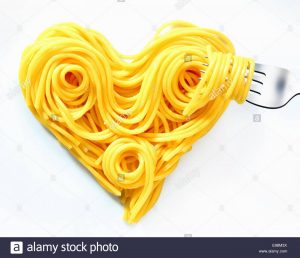The noodle is a staple food in both Italy and China with profound history dates back to Han Dynasty. It could be seen through various lenses and in my blog, I hope to convey its social and cultural value from its nourishment, its heritage, and its procreation. Moreover, I believe noodles serve as a medium for us to bond with family and friend, break the boundaries between rich and poor, and connect with people from different countries.
Firstly, I would like to talk about the significance of noodles in Italian food culture. In our reading The Truth About Pasta, the Sicilians start to make pasta in the early 12th century. It was then rediscovered by Marco Polo and remained a crucial part of Italian diet. The geographical and historical contexts of Italy enable Italians to use various ingredients to prepare their pasta and the pasta are made into different shapes. For example, Anelli is a ring-shaped pasta while orecchiette is an ear-shaped pasta. While Bologna is famous for its Tortellini, Sicily is famous for its Pasta Alla Norma. However, despite the regional differences, Italians mostly follow the Mediterranean food pyramid. The base of the pyramid includes interaction and dining with friends and family. The food pyramid not only indicates the balanced diet of a typical Italian but also shows Italians’ close attention to friendship and kinship. In the “Two Greedy Italians” youtube video people cooking pork-stuffed pasta together, we see how food bringing people together when they talk about table is where people cry and laugh, connect and fall in love.
Similar to Italy, China has distinct noodle dishes with different cooking styles and different “cuts”. China has 56 ethnic groups and is the third largest country in the world. It is a county with profound history and traditions. Thus, it is not surprising that noodles are different across the country due to historical contexts, regional differences, and various ethical traditions. In China, each unique name of noodles has an inspiring story or interesting fact behind it. For example, one of my favorite Dan Dan Noodle gains its name from the street culture. In the old days, vendors would put the ingredients in two bamboo poles and carry them on the shoulder while they walk through the alleys and do their vendor’s cries. The noodle not only carries Chinese heritage and tradition, it also symbolizes the wishes of Chinese people. The longevity noodle serves as one example, as the Chinese pronunciation of “long and slim” noodles is similar to Longevity Noodles. In Bite of China when Ms. Wei woke up to make her husband the Longevity Noodles, she wishes her husband to live long and prosper. Same as the Italians, Chinese people gather up on special occasions to connect with each other. At that time, noodles are always part of the feast.
Moreover, even though it is not mentioned in this week’s reading, I think both Italian pasta and Chinese noodles emphasize harmonizing flavors, timing in cooking, and balancing nutrition. In Porta Palazzo, the ingredients of pasta are carefully chosen, fresh and nutritious; while in Food and Drink Traditions by Liu, noodles are paired with meat and veggies. We talked about Al dente being not too hard or soft when making pasta, in Chinese cookbooks, it is also crucial to handle the cook time for noodles.
Last but not least, I would like to talk about the meaning of noodles from a global perspective. In the group discussion yesterday, we talk about the definition of noodles by Oxford and Cambridge. They use words like “typically”, “usually” to give out the objective definition yet give us space to fill in our definition subjectively. As for me, I think “noodle” represents food culture in eastern and western communities and more. The noodle breaks the boundaries of nationality, social class, and ethnicity. It carries tradition and cultural heritage but also acts as a medium to bring people together. Under the love of noodles, people come together. That’s why I choose the picture below. Life has three principles, nourishment, heritage, and procreation, so does the noodle.

